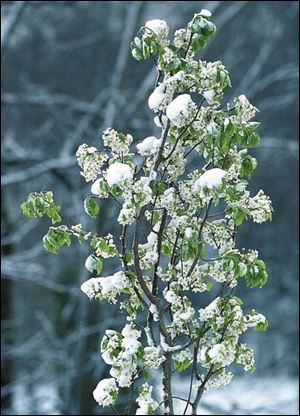
Protect plants from ravages of winter
2/5/2003Sidewalks can be treacherous this time of the year, not only to people walking on the sometimes-slippery surfaces, but to nearby grass and shrubs that become inundated with salt.
To ease sodium overload, protect plants with burlap, keep the area well drained, and use plant-friendly products to melt snow and ice. If possible, rinse the soil to let the salt leach into a larger area. The lower the salt concentration, the better for plants.
Other chemicals will melt snow and cause less damage to plants. Some chemicals will even help plants grow when warm weather returns. Potassium chloride, salt, and magnesium chloride makes a great ice-melting combo. Some ice-melting products don't work when the temperature drops below 20 degrees. Magnesium chloride is the key to start the melting process, even below 20 degrees. Once melting starts, the other two chemicals can do their work.

Snow and ice can make limbs vulnerable to wind.
Potassium is a common ingredient in lawn and garden fertilizer, giving a boost to plants' flowers and fruits.
Urea is another fertilizer that can melt ice. Straight urea comes in BB-sized pellets that can be sprinkled on sidewalks without hurting plants or grass. Urea and calcium chloride pellets are also available at most farm-supply stores.
Kitty litter or limestone also will take some slip out of your step. Ashes, sawdust, and gravel will do the same. These homemade remedies work well, but can make a mess inside the house. Salt and ice from traffic spray can also hurt plants. It's usually obvious because the side facing the road will be brown. Salt runoff can also damage or kill a plant's root system. If you suspect that is happening to your roadside plantings, take a soil test next summer to check your suspicions.
Evergreen trees and shrubs can be damaged by too much salt - and too much snow piled on their branches.
If bushes are heavily covered with snow, knock some of it off with a rake. The weight of the snow can break brittle limbs and, with the added ounces of ice, can make them vulnerable to mild winds.
As a survival technique, evergreens have tiny needles instead of broad leaves to help them through the cold months. These thin needles will hold in some moisture, but constant blustery conditions can suck them dry. Dry fall weather can lead to winter damage because the trees will need to replenish some of that lost moisture through its roots. And if there was little or no moisture in the late fall before the snow fell, the trees could show signs of stress in the spring or early summer. To determine if this happened, check to see if the side of a branch facing the prevailing wind is brown, or if the needles are brown on the tips.